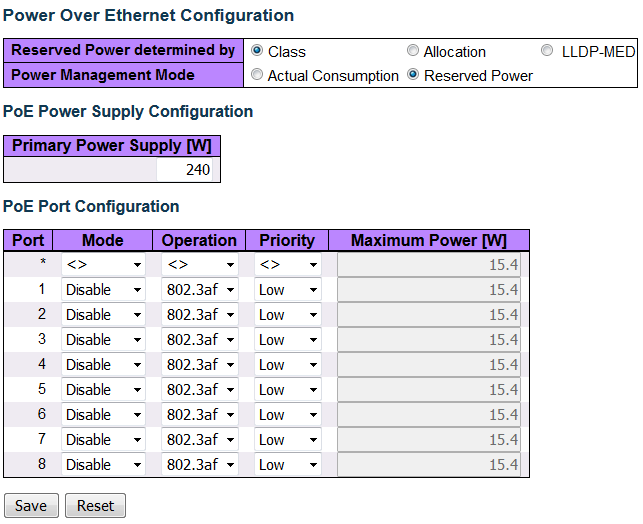PoE
This page allows you to inspect and configure the current PoE port settings.

| Object | Description |
|---|---|
| Reserved Power determined by | |
| Class mode | In this mode each port automatically determines how
much power to reserve according to the class the connected PD belongs to,
and reserves the power accordingly. Four different port classes exist and
one for 4, 7, 15.4 or 30 Watts. In this mode, the Maximum Power fields have no effect. |
| Allocated mode | In this mode you can allocate the amount of power that each port may reserve. The allocated/reserved power for each port/PD is specified in the Maximum Power fields. |
| LLDP-MED mode | This mode is similar to the Class mode expect that
each port determine the amount power it reserves by exchanging PoE
information using the LLDP protocol and reserves
power accordingly. If no LLDP information is available for a port, the port
will reserve power using the class mode In this mode, the Maximum Power fields have no effect. |
| Power Management Mode | |
| Actual Consumption | In this mode the ports are shut down when the actual power consumption for all ports exceeds the amount of power that the power supply can deliver or if the actual power consumption for a given port exceeds the reserved power for that port. The ports are shut down according to the ports priority. If two ports have the same priority the port with the highest port number is shut down. |
| Reserved Power | In this mode the ports are shut down when total reserved powered exceeds the amount of power that the power supply can deliver. In this mode the port power is not turned on if the PD requests more power than available from the power supply. |
| Power Supply Configuration | |
| Power Source | For being able to determine the amount of power the PD may use, it must be defined what amount of power a power source can deliver. Valid values are in the range 0 to 240 Watts. |
| Port Configuration | |
| Port | This is the logical port number for this row. Ports that are not PoE-capable are grayed out and thus impossible to configure PoE for. |
| PoE Mode | |
| Disable | PoE disabled for the port. |
| Enable | Enables PoE for the port. |
| Schedule | Enables PoE for the port by scheduling. |
| Operation Mode | |
| 802.3af | Sets PoE protocol to IEEE 802.3af. |
| 802.3at | Sets PoE protocol to IEEE 802.3at. |
| Priority | |
| The priority is used in the case where the remote devices require more power than the power supply can deliver. In this case the port with the lowest priority will be turn off starting from the port with the highest port number. | |
| Low | The lowest priority. |
| High | The medium priority. |
| Critical | The highest priority. |
| Maximum Power | |
| The Maximum Power value contains a numerical value that indicates the maximum power in watts that can be delivered to a remote device. For port support 4Pairs mode, the maximum allowed value is 60 W; others are 30 W. | |
| Buttons | |
|---|---|
 |
Save changes. |
 |
Undo any changes and revert to previously saved values. |

